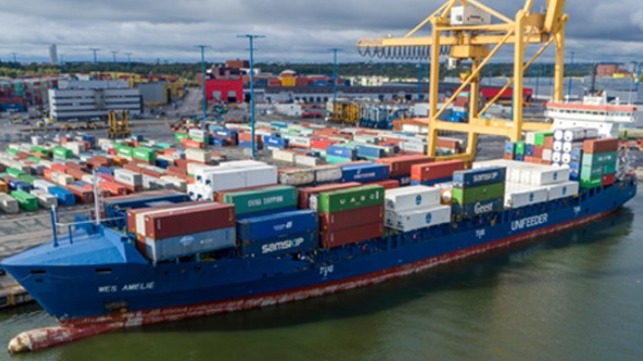Feeder Vessel Runs First Trial Voyage Using Synthetic Natural Gas

A shortsea feeder vessel is operating the world’s first test voyage with liquefied synthetic natural gas (SNG) in the maritime world. The 10,53 gross ton ElbBlue fueled with the carbon-neutral fuel at the German port of Brunsbuttel, near Hamburg for a trip to St. Petersburg, Russia, and a second fueling is planned when it returns to Germany before continuing to Rotterdam.
The trial voyage is the latest in a series of evolutionary efforts involving the feedership. Built in 2010, the vessel, then known as the Wes Amelie, was retrofitted as a dual-fuel vessel with its engine being modified by MAN Energy Solutions. It was the first conversion of a vessel of this size and type to operate on LNG. On April 21, 2019, the Wes Amelie received the first ship-to-ship LNG bunker operation for a container feeder vessel in the Baltic.
Late in 2019, Unifeeder which operates the 1,036 TEU vessel announced plans for the trial using SNG. In the interim, in early 2021, the vessel was sold to Elbdeich Reederei who renamed her ElbBlue. The new owner joined the effort to launch the trial project.
With a blend of 20 tons SNG and 20 tons conventional LNG, the ElbBlue is expected to save approximately 56 tons of carbon output on its coming voyage to St. Petersburg, as opposed to operating on pure LNG. The vessel was fueled with 20 tons of the new SNG for its 20-hour trip to Russia and back.
“The launch of Unifeeder’s SNG trial in conjunction with our project partners is a thrilling and timely development for our business as our industry continues to seek ways to reduce carbon output to meet customer, business, and environmental policy demands," said Jesper Kristensen, CEO of Unifeeder. “A successful trial voyage will complement our environmental initiatives across Europe, such as our investment in more efficient rail and barge inland services, as well as our ongoing sustainability ambitions at our terminals across Europe.”
The SNG is a demonstration product developed by Kiwi in its power-to-gas plant near Cloppenburg, Germany. The company is using wind power to produce green hydrogen. It is then run through a methanation process. Kiwi in 2021 also added a new liquefaction plant. The CO2 used in the process is obtained from a nearby biomethane plant. The fuel was delivered to the vessel by tanker truck because the Elbe estuary has not yet built an LNG bunkering station.
“This is a crucial step on the road to decarbonizing shipping,” said Stefan Eefting, Senior Vice President and Head of MAN PrimeServ, Augsburg, discussing the ElbBlue trial. “In reducing or even eliminating future emissions generated by the global supply chain, synthetic fuels and engine retrofits have a crucial role to play. While a retrofit instantly reduces a ship’s emission levels, synthetic fuels like SNG can enable it to run 100 percent climate-neutrally. Today, we are demonstrating that any LNG-retrofitted ship can also run on fuels generated by power-to-X technology, and even as a mix of fuels depending on availability.”
Discussing the project with the German newspaper Handelsblatt, MAN said that it was only a demonstration project because SNG is not yet commercially viable due to cost and limited supplies. They told the newspaper that the fuel currently costs three to six times that of convention LNG due to the production at a small test plant. They predicted that economies of scale would make the product competitive when as demand grows and large-scale production begins for SNG.
